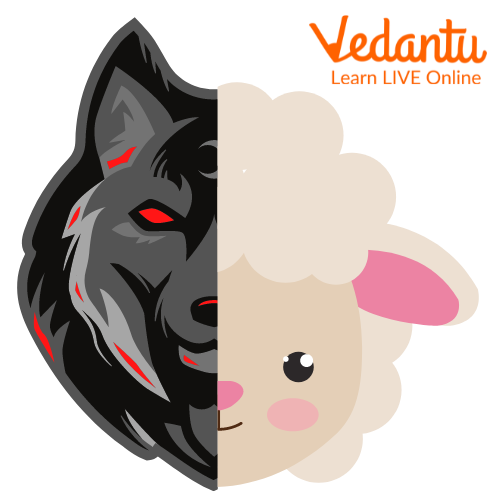A Wolf in Sheep's Clothing Story

Introduction to Story
“A wolf in sheep’s clothing” is a widely famous phrase and a well-known fable. This is the story behind the commonly heard phrase. You must have listened to many stories related to sheep but this is the best one and with the best lesson for kids.
This story follows a wolf who wishes to eat a sheep from a sheep farm. Unable to do so, he finds some abandoned sheep skin and wears it in order to blend in with the rest of the herd. The story tells us what happens as a consequence of the wolf’s actions.
Wolf in Sheep's Clothing
It was a bright morning and near a sheep farm, a wolf roamed. The wolf wanted to eat the sheep but couldn’t as the shepherd and their dogs were watching the flocks too closely. That very night the wolf found some sheep skin that had been sheared from a sheep, cast away, and forgotten. The wolf came up with a cunning plan.

Wolf wearing Sheep skin
The next day the wolf then wore the sheep skin and blended itself into the herd of sheep with the other sheep unaware that a wolf was amongst them. When the shepherd's mind was somewhere else the wolf quickly took the chance and ate the poor sheep. He rejoiced at his win and continued to stay with the flock with the idea of picking another one to eat.
That evening the Wolf entered the fold with the flock still blending in perfectly with them but it just so happens that the shepherds fancied a mutton broth that day. The shepherd went out and picked the first sheep that he could find, which happened to be the wolf disguised in sheep skin. Thus, the wolf that the shepherd mistook for a sheep had been killed and eaten by them.
Moral of The Story
The moral of the story is that “The evil doer often comes to harm through his own deceit.” This means that a person who does evil gets harm in return through their own method.

Wolf and Sheep
The meaning of this story is very clear. If the wolf did not disguise himself as a sheep, the shepherd would’ve not mistaken him for a sheep and he wouldn’t have been eaten as a mutton broth. Hence, we should not do evil to others as the evil will come back to us in the same way we tried to harm others.
Summary
The wolf, wanting to eat the sheep from the sheep farm, disguises himself by wearing sheep skin. Succeeding the first time, the wolf is overcome by his selfish desire of eating more sheep and hence is fated to have a taste of his medicine. The shepherds mistook the wolf for a sheep and ended up eaten by them. This proves that the evil doer often comes to harm through his own deceit.


FAQs on A Wolf in Sheep's Clothing Story
1. What was the fate of the wolf and what happens to the wolf in sheep's clothing's final scene?
The wolf found some forgotten sheep skin and wore it in order to blend into the sheep herd. The shepherds mistook the wolf for one of the sheep and he was killed and eaten as mutton broth.
The wolf put on the skin, fastened it, and then silently crept among the sheep. One young sheep decided to follow the wolf because she thought it was her mother. Finally, before the shepherds could react, the wolf turned around and snatched it up. The wolf followed the sheep that evening as they returned to the barn.
2. What is the moral of “The Wolf In Sheep's Clothing”?
The evil doer often comes to harm through his own deceit. It means that we should not do evil to others as the evil will come back to us in the same way. This narrative has a very apparent significance. The shepherd would not have mistaken the wolf for a sheep and he would not have been consumed as mutton broth if he had not dressed like a sheep. Therefore, we should refrain from harming others because we will experience the same kind of damage in return.




